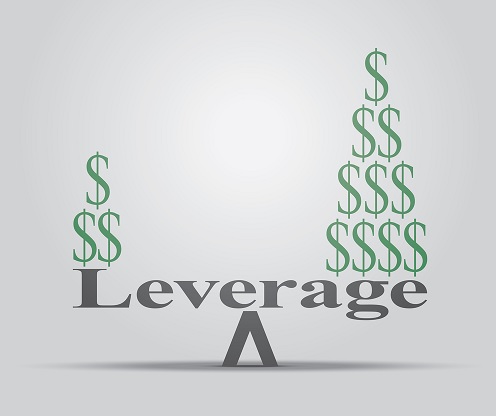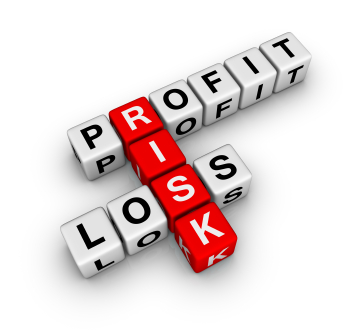Part of the extensive attraction of CFD trading is the fact that CFDs are traded on margin. Margin trading with CFDs is what allows leverage to account for a proportion of each trade, and understanding how and why it works is key to developing a holistic knowledge of successful CFD trading. The margin component of CFD transactions is what sets the degree of leverage applicable to a given trade, and usually this is fixed depending on the market or instrument up for consideration, and expressed as a percentage of equity each trade requires upfront from the trader.
Consider the following example, for a more rounded explanation of how the concept of margin works in terms of the formulation of the transaction. Say the FTSE 100 is tradable with a notional margin requirement of 5%, and you wish to take exposure to the FTSE through CFDs, up to a value of $100 of your capital. This margin requirement means that your capital can effectively go 20 times further with CFDs than with a direct investment, because 95% of the transaction is composed of borrowed funding. So, your $100 in capital becomes 5% of your total available transaction size, which means the total transaction size you can muster becomes $2,000. When the market moves up 10 percentage points, this delivers a $2,200 return, which leaves $200 in gross profit after the leveraged amount is repaid. Thus, the margined nature of the transaction both increases the sizes of the available investment pot, while also ensuring a better rate of return can be realised.
This requirement for margin is notional. There is no need to negotiate financing terms or to consider fluctuating rates of interest – the terms are generally set in concrete and funding automatically approved, so long as the condition of meeting the 5% margin requirement continues to be met. If the position loses value, the margin requirement will adjust to ensure that the trader is always exposed to 5% of the total transaction size at any one time. If the situation arises whereby that 5% is unable to be met by liquid capital, the broker will automatically close out other positions in order to offset against their losses – what’s known in the business as a ‘margin call’. The margin call could see you losing your existing positions at best, or left with a hefty (and entirely legally enforceable) bill at the end of the day.
In worst-case scenarios, you may lose your assets if you run up large enough debts, and you should be consistently aware of the dangers posed by allowing margin-traded transactions to get out of hand. Every additional pound you lose is a pound you have to make up elsewhere, and just because your broker is on the other side of your PC screen makes no difference to the enforceability of your obligations.
While margin trading on CFDs enables traders to engage in positions much more significant than their capital resources would allow, it also presents real and present risks in practice, as a direct result of the degree of leverage built in to these transactions. While the benefits of amplified gains are clear to see, any trader speculating on margin needs to remain fully cognisant of the correlative risks that run alongside greater, leveraged rewards.
Having looked at what margin trading means, and how it translates in practice, that now leads us to look at leverage in a bit more depth, including the advantages and disadvantages it presents traders, along with an analysis of how best the risks of leverage can be mitigated to minimise losses. By examining the function of leverage, and how it intersects with margin and the various different elements of the CFD trading puzzle, you can start to flesh out more concrete ideas about how to make leverage and margin trading work for you and your investment portfolio.
Advantages Of Leverage
The advantages of leverage make perhaps the most compelling case of all for investing in CFDs as an alternative to straight, pound for pound investments. Afforded by the advent of margin trading, leverage has the power to inflate transaction sizes to artificially high levels, allowing for much larger gains to be made on comparatively smaller investments, meaning deployed capital can work much more efficiently than would otherwise be the case, and can deliver returns much more swiftly than most investors would otherwise expect.
Leverage works by establishing a casual borrowing relationship with the broker. Generally, this is offered to traders along with their CFD trading account, and there is no need to apply for leverage or ask your broker to do anything out of the ordinary. Put simply, leverage is automatic, notional funding that is applied by the broker to ‘make up’ to the total transaction size. In many cases, this is done in a ratio of around 1:20, with traders required to fund $1 of every $20 of the total transaction size.
This is equivalent to a margin requirement of 5%. So, for every trade you enter, you stump up 5% of the transaction in the first instance (which is deducted from your available capital), and then (crucially) keep the earnings on 100% of the transaction. When the market moves positively behind your position, you can close out, automatically repaying the amount of leverage footed by the broker in order to absorb the profits from your transaction.
Consider the following practical example. You see a CFD in Company X that catches your eye. With strong reason to believe that Company X will increase in its value over the duration of your investment, you decide to buy CFDs at $1 each to maximise your chances of a return. With $100 capital on the line, you buy $2000 worth of CFDs – bought with the 5% capital deposit of $100 plus the 95% leverage of $1900. When the value of Company X CFDs rises to $1.50, you decide to settle your position and sell up to take your profit.
The profit calculation becomes ($1.50 x 2000) – ($1 x 2000) + $100. Therefore, the profit portion from the trade is worth $3000-$2000+$100=$1,100. On a $100 initial investment, this represents an enormous return on investment that is simply unmatched with alternative means of trading the markets. Of course, this is a simplistic analysis of the figures, and in real life trading scenarios tend to be much more complicated and far less smooth. But it does go some way towards giving an indication of the most significant advantage of leverage.
Note that the leverage portion is silent in the transaction, and is borrowed and repaid without any input from the trader. The only point at which you will be required to act as a result of your leveraged dealings is in the event that the margin amount falls below 5% of the total transaction size, at which point any other liquid capital will be applied to your account, or any profitable positions liquidated to account for your liability. Of course, if the transaction loses value, you still have to repay the leverage amount – even where this extends beyond the amount you have remaining in the trade or in your account.
But aside from being purely a mechanism for boosting profits, leverage can also be a great help in reducing the aggregate losses from your trading portfolio. Imagine you’re sitting with a portfolio with 8 share positions and 2 CFD positions. If you’re down on your share positions, you better believe a profitable CFD position will help eat in to your liabilities. Remember that trading is a game of aggregates, and when aggregating a profit is what you’re after, CFD positions that work to efficiently return capital can be vital to composing a solid and profitable portfolio. Thus, leverage can be greatly advantageous, both as a profit-getter and a loss off-setter, combining the key characteristics of fast and efficient capital return to provide you with a range of trading benefits.
With the same breath, it’s critical to remember that leverage isn’t just a golden chalice from which you can make your fortune, but also a weapon that is potentially fatal to your trading career. In fact, for most traders, the disadvantages of leverage should be read first as a necessary dampener to the excitement that margin trading can instil, to ensure you don’t take unnecessary risks in the process of your CFD trading.
Disadvantages Of Leverage
The advantages of leverage are enough to make even the most experienced trader’s mouth water. The appeal of massive gains from seemingly minimal capital exposure, and the sheer volatility with which positions transpire in CFDs makes it an exciting world in which to do business. Trouble is, real life isn’t always as smooth as it may appear in theory. In fact, there have been growing calls amongst regulators internationally looking to clamp down on the less savvy consumer investment end of the market, with a view to curbing the rise in ‘mum and dad’ traders investing their life savings without a thorough understanding of the ins and outs of this complex and potentially highly risky investment strategy.
Whether you’re a high flying professional trader with years of experience or you’re a complete novice looking to make a quick return on your money, being conscious of the degree of severity of the risks posed by leverage is key to developing a robust risk management approach, and as a result is absolutely fundamental to your success when playing the markets.
The first and arguably most significant disadvantage with leverage is the inverse of its main advantage. When things are going well and the markets are going your way, leverage is a fantastic tool to have on your side, propping up your earnings and increasing the speed of your returns. For maximising your gains from each trade, there isn’t really anything better than massive leverage giving you the benefit of greater buying power. However, when markets and positions start to move against you, things can become pretty difficult pretty quickly with leverage turning against you to cause potentially extensive damage to your trading portfolio.
As leverage moves strongly in your favour, it also moves in equal strength against you when you call a position incorrectly, and both earnings and losses are as equally unlimited. Consider the following example.
Buying CFDs on corn, you assume the market will rise over the course of the day following an upcoming announcement anticipated to show weaker production than last year. For a $50 investment, you take $1000 worth of leveraged exposure to corn, in the hope that prices will rise on the day. But when the figures are released, production has flat lined on the year, surpassing what many had anticipated as being a weak crop. This has a knock-on effect on pricing because supply has remained constant rather than fallen, leading to the widespread selling of corn with speculators looking to cut their potential losses. As an aside, this is the point where you should seriously be looking at offloading your exposure as quickly as possible in order to take a small loss – a small premature loss is far better than a massive loss on a position when it is fully realised.
With corn prices falling by 10% on the day, your position has gone from being worth $1000 to now being worth $900. While this represents a 10% drop on the transaction’s value, it will have devastating implications for the trader.
The $1000 leverage amount still has to be repaid in full to the broker when the position is settled, including any outstanding financing costs. But the position now yields a $100 loss – that’s 200% down on the initial investment of $50. When multiplied over a number of positions across your portfolio, the speed and ruthlessness of leverage in chopping down the value of your positions is what makes it such a dangerous beast.
Aside from the risks posed by leverage in terms of amplifying losses to a greater extent, highly leveraged CFDs are also disadvantages with the passing of time, as a result of the way leverage is charged to traders. Holding a leveraged position overnight attracts a financing cost on the total size of the transaction, expressed as a percentage, and this is payable on every single position held overnight on a daily basis. While the percentages might not seem substantial, they are much more significant when calculated as a percentage of the initial capital deposit.
For example, assume the daily financing charge for a leveraged position is 0.03%. 0.03% on a position worth $1000 is equal to $0.30 per day. However, when that $1000 is actually composed of just $50 in capital, $0.30 becomes 0.6% of your capital exposure, applied as a daily expense. Hold the position for a week, and you’ve paid 4.2% – that’s a 4.2% higher hurdle to overcome towards making a profit. While this is by no means impossible, the higher trading costs associated with funding leveraged positions make calculating the risks and thinking through your trading strategies a must if you’re looking to trade profitably. When coupled with the increased risk profile of trading on margin, this adds up to make leverage a concept that can’t be taken likely.


 The overall impact of leverage is to speed up the trading cycle, and to maximise both profits and losses through trading with larger proportionate stakes. As such, leverage can be seen as the classic double-edged sword – on the one hand, it can deliver wild returns in a matter of minutes that would simply be unattainable in more traditional markets, while on the other it can rip the rug from underneath your feet and cost you your trading livelihood in no time at all, as a result of one or two bad decisions.
The overall impact of leverage is to speed up the trading cycle, and to maximise both profits and losses through trading with larger proportionate stakes. As such, leverage can be seen as the classic double-edged sword – on the one hand, it can deliver wild returns in a matter of minutes that would simply be unattainable in more traditional markets, while on the other it can rip the rug from underneath your feet and cost you your trading livelihood in no time at all, as a result of one or two bad decisions. Leverage is effectively just a short-term, notional loan. It is notional in the sense that you don’t physically receive a loan – it’s simply an automatic credit line extended by your
Leverage is effectively just a short-term, notional loan. It is notional in the sense that you don’t physically receive a loan – it’s simply an automatic credit line extended by your  Most traders who have experienced terminal problems with their accounts have dabbled unsuccessfully with leverage. Most of them will have gotten a little too greedy for their capital to bear, of will simply have made a few critical mistakes along the way. The power of leverage works equally in both directions, whether that happens to be for or against your position, and understanding exactly what impact it can have on your portfolio is the first step towards mitigating against the threats it poses. But how do the risks of leverage factor in to determining how best to deploy your capital?
Most traders who have experienced terminal problems with their accounts have dabbled unsuccessfully with leverage. Most of them will have gotten a little too greedy for their capital to bear, of will simply have made a few critical mistakes along the way. The power of leverage works equally in both directions, whether that happens to be for or against your position, and understanding exactly what impact it can have on your portfolio is the first step towards mitigating against the threats it poses. But how do the risks of leverage factor in to determining how best to deploy your capital?